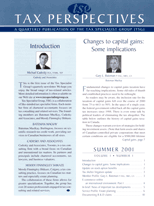
PDF Format
 Issue Contents Issue Contents
 All Issues All Issues
Summer 2001
Volume 1, Number 1
The information in Tax Perspectives is prepared for general interest only. Every effort has been made to ensure that the contents are accurate. However, professional advice should always be obtained before acting and TSG member firms cannot assume any liability for persons who act on the basis of information contained herein without professional advice.
Update on Stock Option Benefits
By Kim Moody, CA, TEP
Moodys LLP Tax Advisors (Calgary)
Changes to stock option benefits were announced in the February 2000 federal budget. The rules are complex, and can backfire on the unwary. Whether they are beneficial depends on how well you play the rules.
Draft legislation implementing the proposals to modify the taxation of stock option benefits has now been released. Previously, if an employee of a publicly traded corporation exercised a stock option, the fair market value (FMV) of the underlying security less the "strike price" was included as a taxable benefit. This was included in the employee's income in the year of exercise, whether or not the security was sold. This often posed problems for employees who could not or did not wish to sell the underlying security. They were often forced to exercise the options and then sell the underlying security to pay the tax on the taxable benefit.
Now, under the draft legislation, where an employee exercises options and holds on to the underlying security, the taxable benefit on the first $100,000 of "specified value" may be deferred. (The specified value is the value of the security at the time the option is granted.)
A number of new planning opportunities are now available. This article highlights the proposals and identifies the opportunities for employees of publicly traded corporations.
HIGHLIGHTS AND OPPORTUNITIES
- To use the $100,000 annual deferral, an election must be filed no later than January 15 of the following year. For 2000, there is no deadline until the draft legislation receives royal assent.
- "Specified value" is computed with respect to an option's "vesting year." No more than $100,000 of specified value can be used for each year that an option vests. This can provide planning opportunities when setting up stock option plans: to maximize the deferral, at least $100,000 of specified value can be established for each employee for each vesting year.
- Where an employee files an election to defer the eligible stock option benefit, the employer is not required to withhold income tax on the otherwise taxable benefit.
- An employee must report the amount of the deferral and related details in prescribed form for every year the deferral is taken.
- The cost of underlying securities acquired via the exercise of stock options where the benefit is deferred is calculated separately from the normal "pooling" calculation. This can provide planning opportunities when determining when and how to dispose of such securities.
- The draft legislation includes new rules with respect to securities that are acquired via the exercise of stock options and disposed of within a 30-day period.
- There are new planning opportunities where options with a number of different vesting years are acquired. Ordering rules in the draft legislation will help in deciding the order in which to dispose of securities so as to maximize the deferral.
- In certain circumstances, an employee can revoke an election to defer the benefit, which may assist in planning opportunities where other deferral decisions should or could have been made.
- The deferral ends when an employee sells the underlying security, or if the employee dies or becomes a non-resident of Canada.
Unfortunately, the new rules do nothing to address one of the most serious drawbacks to stock options. If the stock declines in value after exercise, the result may be a capital loss. This capital loss cannot offset the employment benefit. In extreme cases, this can lead to financial hardship, where the tax on the employment benefit exceeds the value of the shares (after a severe market decline). Exercising options and holding shares can be a dangerous financial strategy, especially with a volatile stock.
CONCLUSION
With this draft legislation, the federal government clearly intends to put Canadian employees of publicly traded corporations on an equal footing with employees in other countries that, until now, have offered more favourable tax treatment than Canada.
The tax specialists of TSG would be happy to provide further information and assistance with respect to stock options. TSG is also preparing a stock option booklet that will be available later this year.
|